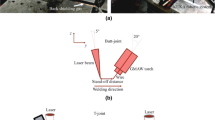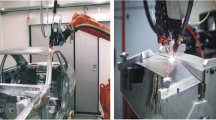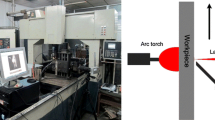Abstract
Hybrid laser-arc welding (HLAW) is a joining process that simultaneously combines arc and laser welding in the same weld pool. The basic concept is to reduce the drawbacks and maximize the advantages of each individual welding process. In the present work, low-alloy steel NK: KD36 plates were welded by HLAW with the following thickness: 7, 9, 14, and 17 mm. The angular distortion and the transverse shrinkage caused by the process were investigated in the welded joint with different weld parameters. The laser-arc hybrid welding experiment was carried out using a 20-kW Yb: fiber laser, together with an arc welding machine (CO2 arc welding). The laser axis was tilted to an angle of 10°, trailing with respect to the normal of the sample surface to avoid back reflections. The arc welding torch was inclined at an angle of 40°. The distance from the focus laser to arc torch was 5 mm. This investigation has shown that the hybrid laser-arc welding offers significant advantages compared with laser welding and arc welding. Compared with the conventional arc welding process, HLAW generates a lower transverse shrinkage and less weld pass for the same plate thickness. Although the coupling of the two processes leads to an increase in the number of parameters, it is the reason for the complexity of this process.







Similar content being viewed by others
References
Kim T-J, Beom-Seon J, Sung-Wook K (2015) Welding deformation analysis based on improved equivalent strain method considering the effect of temperature gradients. Int J Naval Archit Ocean Eng 7(1):157–173
Tian L, Luo Y, Wang Y, Wu X (2014) Prediction of transverse and angular distortions of gas tungsten arc bead-on-plate welding using artificial neural network. Mater Des 54:458–472
Deng D, Murakawa H (2008) Prediction of welding distortion and residual stress in a thin plate butt-welded joint. Comput Mater Sci 43:353–365
Long H, Gery D, Carlier A, Maropoulo PG (2009) Prediction of welding distortion in butt joint of thin plates. Mater Des 30:4126–4135
Ju P, Gyubaek A, Lee H (2012) Effect of external load on angular distortion in fillet welding. Materials and Design, pp:403–410
Katayama, S (2009). Fundamentals of hybrid laser–arc welding . Flemming Ove Olses 28–43
Tsumura S, Murakami K, Gotoh K (2017) A study on the angular distortion in tee type full penetrated welded joint fabricated by the laser-arc hybrid welding. Weld Int 31(12):911–919
Bagger C, Olsen FO (2005) Review of laser hybrid welding. J Laser Appl 17(1):2–14
Casalino G, Dal Maso U, Angelastro A, Campanelli SL (2010) Hybrid laser welding: a review. DAAAM International Scientific Book. pp. 413–430
IONX Technologies laser processing. Publishing Ionix.fi. http://www.ionix.fi/en/technologies/laser-processing/hybrid-laser welding/. Accessed 20 Sept 2019
El Rayes M, Walz C, Sepold G (2004) The influence of various hybrid welding parameters on bead geometry. Weld J 83(4):147–153
Powell J, Lamas J, Karlsson J, Norman P, Kaplan AFH, Yañez A (2011) The sensitivity of hybrid laser welding to variations in workpiece position. Phys Procedia 12:188–193
Graf T, Staufer H (2003) Laser-hybrid welding drives VW improvements. Weld J 82(1):42–48 ISSN 0043-2296
Jasnau U, Hoffmann J, Seyffarth P (2004) Nd: YAG-laser-GMA-hybrid welding in shipbuilding and steel construction, Robotic Welding Intelligence and Automation. Springer, New York, ISBN 3-540-20804-6, pp 14–24
Bunaziv I, Akselsen OM, Frostevarg J, Kaplan AF (2018) Laser-arc hybrid welding of thick HSLA steel. J Mater Process Technol 259:75–87
Satoh K, Terasaki T (1976) Effect of welding conditions on welding deformations in welded structural materials. J Jpn Weld Soc 45(4):42–50 Japanese
Kah P, Salminen A, Martikainen J (2010) The effect of relative location of laser beam with arc in different hybrid welding processes. Mechanika 83(3):68–74
Frostevarg J (2018) Factors affecting weld root morphology in laser keyhole welding. Opt Lasers Eng 101:89–98
Tang G, Zhao X, Li R, Liang Y, Jiang Y, Chen H (2020) The effect of arc position on laser-arc hybrid welding of 12-mm-thick high strength bainitic steel. Opt Laser Technol 121:105780
Liu Z, Kutsuna M, Xu G (2006) Properties of CO2 laser-GMA hybrid welded high strength steel joints.-IIWDOC. IV-907-06, 10p
Abe N, Hayashi M (2002) Trends in laser arc combination welding methods. Weld Int 16(2):94–98
Casalino G, Campanelli SL, Dal MU, Ludovico AD (2013) Arc leading versus laser leading in the hybrid welding of aluminium alloy using a fiber laser. Proc CIRP 12:151–156
Irfan YA, Memduh K, Ezgi D (2018) Angular distortion in butt arc welding. Int J Eng Sci Appl 2(4)
Akella S, Kumar BR (2013) Distortion control in TIG welding process with Taguchi approach. Adv Mater Manuf Charact 3:199–205
Arunkumar S, Rangarajan P, Devakumaran K, Sathiya P (2015) Comparative study on transverse shrinkage, mechanical and metallurgical properties of AA2219 aluminium weld joints prepared by gas tungsten arc and gas metal arc welding processes. Def Technol 11:262–268
Singh R(2016) Stress, shrinkage, and distortion in weldments. Appl Weld Eng (Second Ed). 201–238
Acherje B (2018) Hybrid laser arc welding: state-of-art review. Opt Laser Technol 99:60–71
Funding
This work was supported by Kyushu University, Department of Marine Systems Engineering, Fukuoka, Japan, as well as by CAPES and FINEP.
Author information
Authors and Affiliations
Corresponding author
Additional information
Publisher’s note
Springer Nature remains neutral with regard to jurisdictional claims in published maps and institutional affiliations.
Rights and permissions
About this article
Cite this article
Fernandes, C.A., do Vale, N.L., de Abreu Santos, T.F. et al. Investigation of transverse shrinkage and angular distortion caused by hybrid laser-arc welding. Int J Adv Manuf Technol 107, 4705–4711 (2020). https://doi.org/10.1007/s00170-020-05343-5
Received:
Accepted:
Published:
Issue Date:
DOI: https://doi.org/10.1007/s00170-020-05343-5




